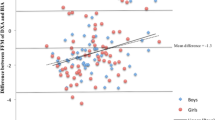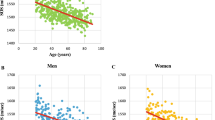Abstract
Background/Objectives:
Quantitative ultrasound (QUS) is used to measure bone quality and is known to be safe, radiation free and relatively inexpensive compared with dual-energy X-ray absorptiometry (DXA) that is considered the gold standard for bone status assessments. However, there is no consensus regarding the validity of QUS for measuring bone status. The aim of this study was to compare QUS and DXA in assessing bone status in Thai children.
Subjects/Methods:
A total of 181 Thai children (90 boys and 91 girls) aged 6 to 12 years were recruited. Bone status was measured by two different techniques in terms of the speed of sound (SOS) using QUS and bone mineral density (BMD) using DXA. Calcium intake was assessed by 24 h diet recall. Pearson’s correlation, κ-statistic and Bland and Altman analysis were used to assess the agreement between the methods.
Results:
There was no correlation between the two different techniques. Mean difference (s.d.) of the Z-scores of BMD and SOS was −0.61 (1.27) that was different from zero (P<0.05). Tertiles of Z-scores of BMD and QUS showed low agreement (κ 0.022, P=0.677) and the limits of agreement in Bland and Altman statistics were wide.
Conclusions:
Although QUS is easy and convenient to use, the SOS measurements at the radius seem not appropriate for assessing bone quality status.

Similar content being viewed by others
References
Committee to Review Dietary Reference Intakes for Vitamin D and Calcium, Food and Nutrition Board, Institute of Medicine Dietary Reference Intakes for Calcium and Vitamin D. National Academy Press: Washington, DC, 2010.
Pietrobelli A, Formica C, Wang Z-M, Heymsfield SB . Dual energy X-ray absorptiometry body composition model: review of physical concepts. Am J Physiol 1996; 271: E941–E951.
National Osteoporosis Society Bone Densitometry Techniques II: Single and Dual Energy X-ray Absorptiometry (cited 10 February 2015). Available from: https://www.nos.org.uk/document.doc?id=654.
Watkins J . Structure and Function of the Musculoskeletal System, 2nd edn. Human Kinetics: Champaign, IL, USA, 2010.
Zittermann A, Gummert JF, Börgemann J . Vitamin D deficiency and mortality. Curr Opin Nutr Metab Care 2009; 12: 634–639.
Prins SH, Jorgensen HL, Jorgensen LV, Hassager C . The role of quantitative ultrasound in the assessment of bone: review. Clin Physiol 1998; 18: 3–17.
Krieg MA, Barkman R, Gannelli S, Stewart A, Bauer DC, Barquero LD et al. Quantitative ultrasound in the management of osteoporosis: the 2007 ISCD official position. J Clin Densitom 2008; 11: 163–187.
Rojroongwasilkul N, Kijboonchoo K, Wimonpeerapattana W, Purttiponthanee S, Yamborisut U, Boonpraderm A et al. SEANUTS: the nutritional status and dietary intake of 0.5-12-year-old Thai children. Br J Nutr 2013; 110: S36–S44.
Chailurkit LO, Aekplakorn W, Ongphiphadhanakul B . Regional variation and determinants of vitamin D status in sunshine-abundant Thailand. BMC Public Health 2011; 11: 853.
EI-Desouki MI, Sherafzal MS, Othman SA . Comparison of bone mineral density with dual energy x-ray absorptiometry, quantitative ultrasound and single energy x-ray absorptiometry. Saudi Med J 2005; 26: 1346–1350.
De Onis M, Onyango AW, Borghi E, Siyam A, Nishida C, Siekmann J . Development of a WHO growth reference for school-aged-children and adolescents. Bull World Health Organ 2007; 85: 660–667.
Gordon CM, Bachrach LK, Carpenter TO, Crabtree N, El-Hajj Fuleihan G, Kutilek S et al. Dual energy X-ray absorptiometry interpretation and reporting in children and adolescents: the 2007 ISCD pediatric official position. J Clin Densitom 2008; 11: 43–58.
Bland JM, Altman DG . Statistical methods for assessing agreement between two methods of clinical measurement. Lancet 1986; 116: 307–310.
Du X, Greenfield H, Fraser DR, Ge K, Zheng W, Huang L et al. Low body weight and its association with bone health and pubertal maturation in Chinese girls. Eur J Clin Nutr 2003; 57: 693–700.
Williams JE, Wilson CM, Biassoni L, Suri R, Fewtrell MS . Dual energy X-ray absorptiometry and quantitative ultrasound are not interchangeable in diagnosing abnormal bones. Arch Dis Child 2012; 97: 822–824.
Christoforidis A, Economou M, Papadopoulou E, Kazantzidou E, Gompakis N, Athanassion-Metaxa M . Bone status of children with hemophilia a assessed with quantitative ultrasound sonography (QUS) and dual energy X-ray absorptiometry (DXA). J Pediatr Hematol Oncol 2010; 32: e259–e263.
Christoforidis A, Perifanis V, Papadopoulou E, Dimitriadou M, Kazantzidou E, Vlachaki E et al. Poor correlations between measurements of bone quality by qualitative ultrasound sonography and dual energy X-ray absorptiometry in patients with β-thalassaemia major. Eur J Haematol 2008; 82: 15–21.
Chong KH, Poh BK, Aini JN, Azmi KN, Deurenberg P . Radial quantitative ultrasound and dual energy X-ray absorptiometry: inter-method agreement for bone status assessment in children. Biomed Res Int 2015; 2015: 1–7.
Fielding KT, Nix DA, Bachrach LK . Comparison of calcaneus ultrasound and dual X-ray absorptiometry in children at risk of osteopenia. J Clin Densitom 2003; 6: 7–15.
Jones G, Boon P . Which bone mass measures discriminate adolescents who have fractured from those who have not? Osteoporis Int 2008; 19: 251–255.
Acknowledgements
We are grateful to the children and their parents for their participation in this study. We also thank all staff at the Institute of Nutrition, Mahidol University, especially Kriyot Sudsa-ard, Rittirong Unjana and Petcharat Kunaphan for their help during the DXA measurements. Special thanks to the technicians of Golden Jubilee Medical Center, Mahidol University who were involved in the DXA measurements. FrieslandCampina, The Netherlands, sponsored the study.
Author contributions
WS and PD were responsible for the data analyses and reporting. WT, KK, NR and WW were closely involved in the data collection and NR, IK and PD were involved in the design of the study. All authors contributed to the manuscript writing.
Author information
Authors and Affiliations
Corresponding author
Ethics declarations
Competing interests
The authors declare no conflict of interest.
Rights and permissions
About this article
Cite this article
Srichan, W., Thasanasuwan, W., Kijboonchoo, K. et al. Bone status measured by quantitative ultrasound: a comparison with DXA in Thai children. Eur J Clin Nutr 70, 894–897 (2016). https://doi.org/10.1038/ejcn.2015.180
Received:
Revised:
Accepted:
Published:
Issue Date:
DOI: https://doi.org/10.1038/ejcn.2015.180
- Springer Nature Limited
This article is cited by
-
Factors associated with bone health status of Malaysian pre-adolescent children in the PREBONE-Kids Study
BMC Pediatrics (2021)
-
Validity of quantitative ultrasound and bioelectrical impedance analysis for measuring bone density and body composition in children
European Journal of Clinical Nutrition (2021)




